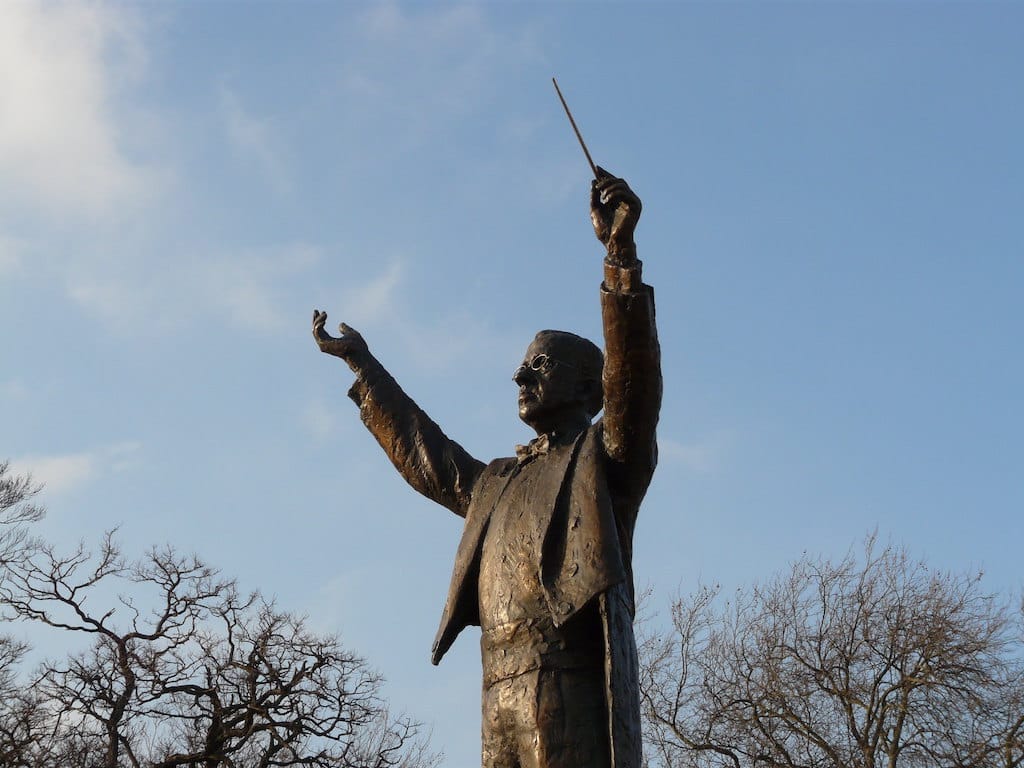The Cloud Messenger

This is the 150th birth anniversary of English composer, arranger and teacher Gustav Theodore Holst (1874 – 1934). Although best known for his orchestral suite ‘The Planets’ (1918), this year presents an appropriate opportunity to revisit the rest of his vast oeuvre. This is precisely what is happening at the ongoing BBC Proms festival, the annual eight-week summer festival of daily orchestral classical music concerts and other events in the UK.
One such concert that I listened to on internet radio (and is still available for the next two months or so, for those interested) featured a particularly interesting work by him, his choral epic ‘The Cloud Messenger,’ Opus 30.
Holst played trombone in theatre orchestras, and was organist in various churches, when he learned that, as he put it, "man cannot live by composition alone." It was perhaps on one such excursion that he came upon a book on Eastern philosophy in Scarborough. According to writer and BBC broadcaster Dr. Kate Kennedy, it awakened an interest in Indian music that took him to the British Library. Undeterred by the fact that most of the texts were in Sanskrit, Holst taught himself the language, attending specialized evening courses to this end. This led to the “Indian period” of his compositional oeuvre, roughly between the years 1901 to 1915. The list of Indian-themed works is long, and ‘The Cloud Messenger’ (1913) is one of them.
Incredibly, it received its Proms debut only this year, more than a century after it was written, performed here by the BBC Symphony Orchestra (which is not only the BBC’s principal broadcast orchestra, but also the principal orchestra of the BBC Proms), the BBC Symphony Chorus, and contralto Jess Dandy under the baton of principal conductor Sakari Oramo.
The reason for the lapse is the large forces needed for the work. Its reputation was also tainted by a disastrous premiere in 1913 (incidentally, the same year as Stravinsky’s riotous ‘Rite of Spring’ premiere, although the works are poles apart in every sense). Somehow, it was forgotten that a semi-chorus was needed to sing the Cloud’s text, a glorious moment after the work’s great climax. So the part had to be sight-read on the night of the premiere.
‘The Cloud Messenger’ is the English translation of ‘Meghadūta’, a lyric poem written by Kalidas (c. 4th–5th century CE), considered to be one of the greatest Sanskrit poets. The 120-stanza poem is among his most famous works. In the poem, a yakṣha (nature spirit), who had been banished by his master to a remote region in central India for a year, requests a cloud to take a message of love to Mount Kailash in the Himalayas where his loyal wife awaits his return.
The poem inspired other poets to write similar poems (known as "messenger-poems", or Sandesh Kavya) on similar themes.
As in all the other Sanskrit texts that Holst set to music, the English translations, word for word, are painstakingly his own. I have tried going through the Sanskrit text for Meghadūta’ online, and can appreciate the labour and diligence involved in the task. It took Holst “seven happy years” (his words) just for the translation.
Holst started writing the music in 1909 and completed it the next year, not much before ‘The Planets’ Opus 32, a very different work in every respect, (although you can hear shades of ‘Neptune’ towards the end of ‘The cloud Messenger’).
The lukewarm reception to the 1913 premiere of ‘The Cloud Messenger’ greatly disappointed Holst. Even as recently as 1995, musicologist Alan Edgar Frederic Dickinson, in his book ‘Holst’s music: A guide’ dismissed ‘The Cloud Messenger’ as an "accumulation of desultory incidents, opportunistic dramatic episodes and ecstatic outpourings" which illustrate the composer's creative confusion during that period. Imogen Holst (1907 -1984), the composer’s own daughter, and also a composer, conductor and musicologist in her own right, termed the work “a dismal failure.”
But as Kennedy pointed out in the discussion aired during the interval of this year’s Prom concert, one of the advantages of reappraising composers’ works, particularly Holst, is that some of their output was so far ahead of its time then, that it might even seem contemporary now.
I found the Prom performance so beguiling that I listened to it again, but this time by following the score and Holst’ text online, on IMSLP (International Music Score Library Project, also known as the Petrucci Music Library). For those interested, even if you cannot read music notation, you can easily follow the vocal score on the site.
This is Holst as I have never heard him before, a ravishing expression of late-romanticism. If all you’ve heard of his works before is ‘The Planets’ and maybe his St. Paul’s suite (opus 29), you are in for a real treat.
I also found it delightfully ironic that despite being Indian, it took my love of western classical music to get so closely acquainted with the work of one of the greatest Sanskrit poets of antiquity, even if in translation.
Somewhere in the early 2000s I found myself one Bank Holiday weekend in Cheltenham and was pleased to find that Holst’s birthplace home had been turned into a museum in 1974. I spent the whole day there. A portion of the Victorian house celebrates his life, while another section gives visitors, young and old, a hands-n education about life in nineteenth-century England, before electricity and the modern comforts that came with it.
Yet again, it made me think we could and should be doing the same here, with for instance the houses of Abade Faria or Ángelo da Fonseca, just to name a couple of Goa’s famous figures. Besides just having the house open to visitors, the Holst Victorian House (wwwholstvictorianhouse.org.uk) also hosts events ranging from exhibitions, workshops and activities for all ages, book groups, nature trails, many of which are sold out. Goa has so much more to offer than the vacuous hedonism that our government seems keen to offer the visitor and brand Goa: casinos, drug-fuelled raves and Sunburn ‘festivals’.
The Holst Museum has a kiosk where you can scroll through his original scores while also listening to the music. You can also scroll through some of his scores on their website. You won’t (yet) find ‘The Cloud Messenger’ but there’s another India-themed work: Choral hymn from the ‘RigVeda’ Opus 26. You have to marvel at the neatness and accuracy of Holst’s penmanship. Either he had a very steady hand, or he used a ruler for the note-stems and the joined tails of quavers, semiquavers etc.
I’ll leave you with the food for thought provided by the final lines of text of ‘The Cloud Messenger’:
“Yet who hath perpetual joy or sorrow? Our lot doth go now up, now down, like the rim of a wheel. No yearning can shorten the days of my exile that still remain. Let this my message bring thee comfort to the parched earth.”
This article first appeared in The Navhind Times, Goa, India.





